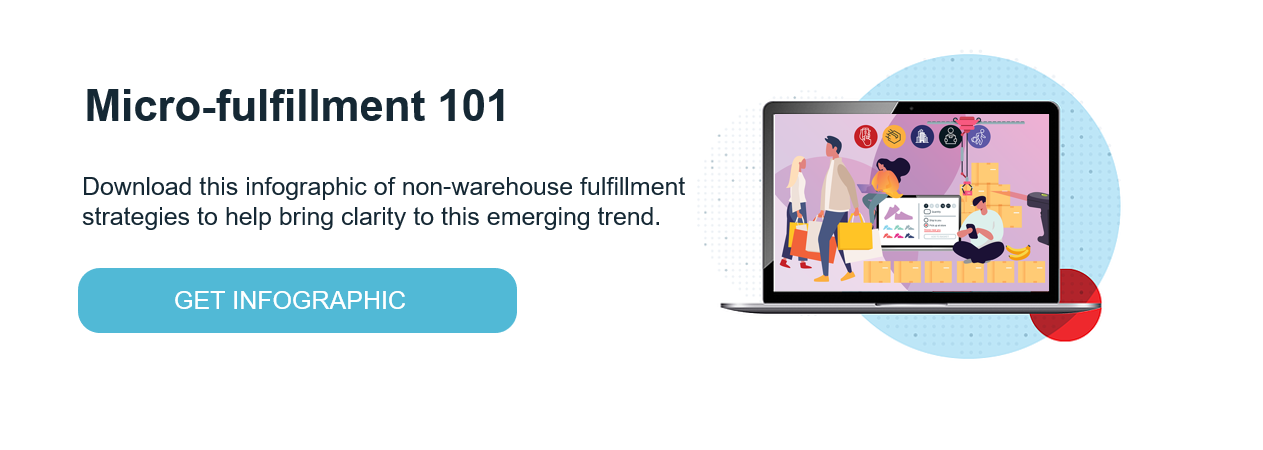Micro-fulfillment vs. Store Fulfillment: What’s the Difference and Which One is Right for Your Business?

The next big match-up is here: micro-fulfillment vs. store fulfillment. What’s the difference between these two types of fulfillment strategies and how do you determine which one is right for your business? At Tecsys, we have been working in retail supply chain for more than 14 years and one thing we have been hearing a lot lately is confusion around micro-fulfillment and store fulfillment. Let me explain both strategies and why one works better for certain situations than another.
Micro-fulfillment and Store Fulfillment Definitions
Micro-fulfillment is a process sometimes referred to as “store-as-warehouse.” In this model, store associates act as “pickers” and are directed to the shelf locations — in the stockroom or showroom — by mobile devices such as hand terminals equipped with scanners, making for efficient and cost-effective fulfillment and real-time inventory management. This advanced level of control and efficiency is ideal for department stores, big box stores, warehouse stores or retailers that want to use stores as e-commerce fulfillment centers in order to eliminate or significantly reduce their dependence on warehouse operations.
Store fulfillment is a process performed by store associates and items are retrieved as needed from store shelves or the stockroom. The associates are not directed to the item location and the item inventory is consumed by the order management system (OMS) — not by an inventory management system. It’s generally ideal for retailers with small footprint stores or retailers that need to implement click and collect quickly.
Micro-fulfillment and Store Fulfillment Pros and Cons
Now the choice between these two seemingly similar strategies is a balancing act between adding complexity and reducing errors, between cost of failure and level of efficiency. Let’s dig a little deeper. There is a cost associated to the errors that are made in picking or packing an order. The more errors you make, the more that order is going to cost your business. We call that our “cost of failure.” Naturally, it’s a higher investment in having more control to reduce the amount of errors.
A micro-fulfillment strategy offers greater controls. Micro-fulfillment systems not only keep track of all the inventory in the store and the storeroom, but the system tells the associate exactly where to go and which item to pick. In order to do this though, the system needs to be told where the item is located in the first place (unlike a store fulfillment operation). Afterwards, the micro-fulfillment system manages the consumption of goods. An additional benefit of a micro-fulfillment system is that you can be very smart about using your store associates’ time. You might have associates pick many orders simultaneously. Another option to consider is splitting waves of orders between multiple associates and having certain items picked by one associate and the rest by another only to have them married back up in the packing process.
A store fulfillment strategy offers less controls. The business is mainly relying on a store associate ‘doing a good job and picking the right items.’ With store fulfillment, the associate is simply directed to go get x, y and z, but there are no additional instructions as to where to go to get the items or even more specifics on which items to get. There is no process or workflow in a step-by-step way for the associate to follow. In effect, it gives the associate a shipping list and expects him or her to go find it based upon their knowledge of the store layout, get the right stuff and package it in the right way.
Which Fulfillment Strategy Should You Use?
In our experience at Tecsys, store fulfillment works just fine when your operations are relatively simple, volumes are low and items in your store are easy to identify. As your in-store fulfillment operations becomes more complex or your volumes increase, you are more likely to need a micro-fulfillment system. Situations that should make you consider a micro-fulfillment are:
- If you need to pick many orders at the same time to reduce in-store disruption.
- If you have items that expire and need to be selected in a first-in, first-out process.
- If you have items that mostly look alike and are harder to identify, such as shoes or makeup.
- If you run a high-service operation where mistakes in order fulfillment are simply unacceptable.
Like most things in business, micro-fulfillment versus store fulfillment is a balancing act. Your perfect approach might be a combination of the two or mostly one versus the other. It is a study you need to make based on your business and your customers. Either way, at Tecsys we can help you if you have questions or would like to understand more.




